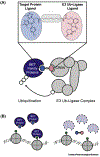Pharmacological Modulation of Transcriptional Coregulators in Cancer
- PMID: 31078321
- PMCID: PMC6746237
- DOI: 10.1016/j.tips.2019.04.004
Pharmacological Modulation of Transcriptional Coregulators in Cancer
Abstract
Upon binding of transcription factors to cis-regulatory DNA sequences, transcriptional coregulators are required for the activation or suppression of chromatin-dependent transcriptional signaling. These coregulators are frequently implicated in oncogenesis via causal roles in dysregulated, malignant transcriptional control and represent one of the fastest-growing target classes in small-molecule drug discovery. However, challenges in targeting coregulators include identifying evidence of cancer-specific genetic dependency, matching the pharmacologically addressable protein fold to a functional role in disease pathology, and achieving the necessary selectivity to exploit a given genetic dependency. We discuss here how recent trends in cancer pharmacology have confronted these challenges, positioning coregulators as tractable targets in the development of new cancer therapies.
Keywords: cancer; chromatin; therapeutics; transcription.
Copyright © 2019 Elsevier Ltd. All rights reserved.
Figures



References
-
- Zentner GE and Henikoff S (2013) Regulation of nucleosome dynamics by histone modifications. Nature Structural & Molecular Biology 20, 259–266 - PubMed
-
- Clapier CR and Cairns BR (2009) The Biology of Chromatin Remodeling Complexes. Annu. Rev. Biochem 78, 273–304 - PubMed
-
- Kaelin WG (2017) Common pitfalls in preclinical cancer target validation. Nat Rev Cancer 17, 425–440 - PubMed
Publication types
MeSH terms
Substances
Grants and funding
LinkOut - more resources
Full Text Sources

